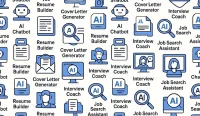The New Reality For Juniors
It’s not your imagination—this market is toughest on juniors and new grads. Big Tech throttled new‑grad intake after the 2021–2022 binge and many firms quietly redefined “entry‑level” to mean “two years of industry experience.” New entry‑level hires are down since 2023 even as mid‑ and senior‑level roles rebound. The signal from job boards is consistent: roles tagged “junior” or “entry” often require production experience, and the only true no‑experience postings are internships (frequently limited to currently enrolled students).
Meanwhile, anxiety got a megaphone. A viral clip from Anthropic’s CEO projected that up to half of white‑collar entry‑level tasks could be automated within five years. The New York Fed reported computer science grads ranking among the higher‑unemployment majors, adding to the gloom. And yet, a separate Fed survey noted AI’s labor impact is currently too small to detect. Both can be true: near‑term hiring preferences can shift away from juniors without a wholesale collapse of demand for software talent.
Why Mid/Senior Is Recovering
Three dynamics explain the divergence:
1) Experience scarcity: The engineering workforce is a pyramid—many juniors, fewer mid‑levels, and a relatively small pool of seniors. Not everyone who starts as a junior becomes senior; attrition happens at every rung. In tight cycles, companies prioritize fewer but more self‑sufficient hires.
2) Training burden risk: Juniors are temporarily a net drag on teams—onboarding, code reviews, pairing, and rework consume scarce senior time. In 2021–2022, companies accepted that cost because demand outstripped supply. In today’s normalized demand, they can wait for candidates who ship value on week one.
3) Task mix shifted: The lowest‑risk tickets that used to belong to juniors—small UI tweaks, validation, boilerplate integrations—are now accelerated by AI and better internal tooling. That doesn’t erase the need for engineers; it changes where human judgment is most valuable (architecture, data quality, integration risk, production reliability, security, compliance). Those are mid/senior domains.
The result is a “senior‑only vibe” even when total tech headcount stabilizes or grows. It’s not that juniors are useless; it’s that the current cost model favors fewer hires with broader impact.
AI: What’s Real Vs. Scapegoat
Reality: AI already helps automate some entry‑level tasks (code scaffolding, test generation, docs, simple CRUD). That trims the backlog of safe tickets that once served as ramp work. It also raises the bar on review quality—humans must catch model mistakes and own outcomes.
Scapegoat: Companies can over‑credit AI to justify cuts. When firms claim “AI replaced 20% of our entry roles,” sometimes they actually mean “we slowed hiring and re‑scoped work.” Multiple surveys show AI adoption is uneven, ROI is concentrated in narrow workflows, and macro hiring preferences loom larger than robots taking jobs—at least for now.
The practical takeaway: assume AI is part of the job. Treat it as force‑multiplier, not rival. The more you can orchestrate AI toward outcomes (not outputs), the more valuable you become—even as a new grad.
AI Isn’t Taking Jobs — It’s Changing Them
The engineers who thrive aren’t fighting AI — they’re mastering it. Learn how to turn automation into an advantage and stay ahead of the hiring curve.
Explore AI-Augmented Roles →How To Break In: A Practical Playbook
You don’t need nine lifetimes. You need a short, repeatable plan that creates evidence you can do the job today.
1) Pick a thin slice with business value. Examples: cost‑saving internal tool, data quality guardrail, support deflection bot, usage analytics pipeline with alerts, SLA dashboard tied to SLOs. Tie it to a metric (tickets resolved, minutes saved, dollars avoided, errors prevented).
2) Build two production‑looking projects end‑to‑end. Ship a working demo, README, deployment script, and a short “Operations Notes” section that covers logging, metrics, fallback, and rollback. Show you thought about reliability, not just features.
3) Use AI like a pro. Document how you used AI to accelerate: prompts, constraints, evaluation steps, and how you corrected model mistakes. Hiring managers want proof you can supervise AI, not just paste code.
4) Create proof artifacts. A one‑pager per project with: problem, approach, stack, risks, metrics before/after, and what you’d do next with a team. Link to repo, live demo, and a 90‑second Loom walkthrough.
5) Reduce competition. Apply to on‑site or hybrid roles first; fully remote has the deepest applicant pools. Target smaller companies, non‑tech sectors, universities, and labs that still train hands‑on.
6) Get real references fast. Do two short, free/low‑paid engagements for a nonprofit or local business. Time‑box to 2–3 weeks, ship one concrete improvement, and ask for a public testimonial and LinkedIn recommendation.
7) Prepare for the raised bar. Practice system design and debugging narratives, not just leetcode. Frame answers around trade‑offs, failure modes, and observability. Show that you think like a junior architect in training.
Key Takeaway
This isn’t the end of junior hiring—it’s a demand for evidence. AI removed some easy tickets and raised expectations, pushing companies to favor self‑starters. Win by shipping production‑minded projects, supervising AI well, narrowing competition, and proving you move a metric—not just write code.
FAQs
Are juniors being replaced by AI?
Some tasks are, but roles aren’t wholesale disappearing. Companies still need humans to design, integrate, evaluate, secure, and own outcomes.
Why do “entry‑level” jobs require two years?
Firms price in the training burden. “Entry‑level” is often shorthand for “independent on small‑to‑medium tasks with minimal oversight.”
What should I prioritize learning?
Fundamentals (data structures, HTTP, SQL), system design basics, cloud deploys, observability, and AI supervision. Depth beats chasing every new framework.
How do I stand out among hundreds of applicants?
Show before/after metrics, production hygiene, and a short video walkthrough. Apply to on‑site/hybrid and smaller organizations first.
Will this get better?
Likely. As cohorts thin and AI‑generated code accumulates, demand for experienced engineers—and people who can clean up “AI slop”—should rise. Breaking in now positions you for that upswing.





Will there be jobboards in two years ahead?